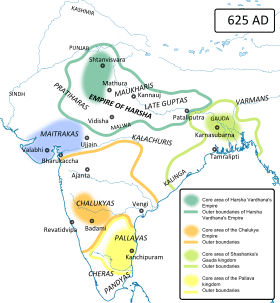Gauda Kingdom
| Kingdom of Gauda | ||||||||||||
| Bengali: গৌড় রাজ্য (Gāur Rājya) | ||||||||||||
| ||||||||||||
 Gauda (in eastern India) and its contemporaries, c. 625 CE | ||||||||||||
| Capital | Karnasuvarna (present day West Bengal, India) | |||||||||||
| Religion | Hinduism Buddhism | |||||||||||
| Government | Monarchy | |||||||||||
| King | ||||||||||||
| • | 590–625 | Shashanka | ||||||||||
| • | 625–626 | Manava | ||||||||||
| History | ||||||||||||
| • | Established | 590 | ||||||||||
| • | Disestablished | 626 | ||||||||||
| ||||||||||||
Part of a series on the |
|---|
| History of Bengal |
 |
| Ancient geopolitical units |
| Ancient and classical dynasties |
| Medieval and Early Modern periods |
| European colonisation |
| Bangladesh |
| Indian Bengal |
| Related |
Gauda Kingdom (Bengali: গৌড় রাজ্য Gāur Rājya), was a Hindu power during the Late Classical period on the Indian subcontinent, which originated in the region of Bengal.[1][2]
Location and extent
King Shashanka (Bengali: শশাঙ্ক Shôshangko) is often attributed with creating the first separate political entity in a unified Bengal called Gauda. He reigned in 7th century, and some historians place his rule approximately between 590 and 625. His capital was at Karnasubarna, 9.6 kilometres (6.0 mi) south-west of Baharampur, headquarters of Murshidabad district.[1]
The Chinese monk, Xuanzang (Hiuen Tsang) travelled from the country of Karnasubarna to a region in Orissa ruled by Shashanka.[2] There is mention of Pundravardhana being part of Gauda in certain ancient records.[3]
Evidence seems to be discrepant regarding links of Gauda with the Rarh region. While Krishna Mishra (11th or 12th century), in his Prabodha-chandrodaya, mentions that Gauda rashtra includes Rarh (or Rarhpuri) and Bhurishreshthika, identified with Bhurshut, in Hooghly and Howrah districts, but the Managoli inscription of the Yadava king Jaitugi I distinguishes Lala (Rarh) from Gaula (Gauda).[1]
According to Jain writers of the thirteenth and fourteenth centuries, Gauda included Lakshmanavati in present-day Malda district.[1]
Following his death, Shashanka was succeeded by his son, Manava, who ruled the kingdom for eight months. However Gauda was soon divided amongst Harshavardhana and Bhaskarvarmana of Kamarupa, the latter even managing to conquer Karnasuvarna.
The Pala emperors were referred to as Vangapati (Lord of Vanga) and Gaudesvara (Lord of Gauda). Sena kings also called themselves Gaudesvara. From then Gauda and Vanga seem to be interchangeable names for whole of Bengal.[1]
References
- 1 2 3 4 5 Majumdar, Dr. R.C., History of Ancient Bengal, first published 1971, reprint 2005, pp. 5-6, Tulshi Prakashani, Kolkata, ISBN 81-89118-01-3.
- 1 2 Ghosh, Suchandra (2012). "Gauda, Janapada". In Islam, Sirajul; Jamal, Ahmed A. Banglapedia: National Encyclopedia of Bangladesh (Second ed.). Asiatic Society of Bangladesh.
- ↑ Bandopadhyay, Rakhaldas, Bangalar Itihas, (Bengali), first published 1928, revised edition 1971, vol I, p 101, Nababharat Publishers, 72 Mahatma Gandhi Road, Kolkata.
Coordinates: 24°11′N 88°16′E / 24.18°N 88.27°E